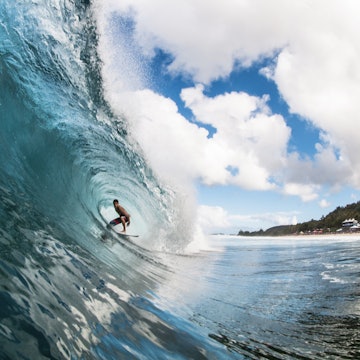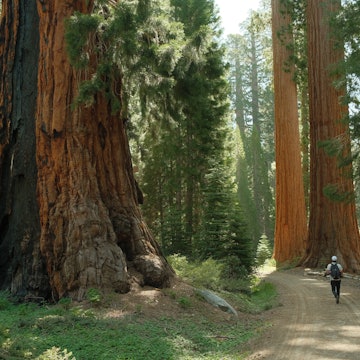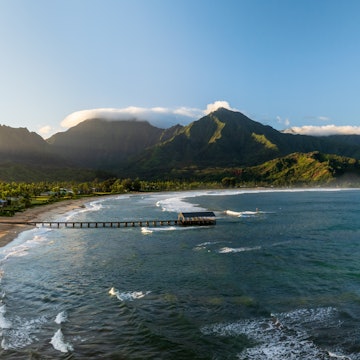
How Hawaiians are using traditional practices to promote sustainability

Dec 22, 2019 • 8 min read

Hawaii is at once ancient and new, where traditional practices are being used in novel ways © JTSorrell / Getty Images
On the island of Hawai‘i a group of individuals is changing tourism culture from the inside out, incorporating traditional Hawaiian concepts of land stewardship and sustainability into education systems aimed at both the citizens of Hawaiʻi and the island’s visitors.
Through these efforts, they hope to keep Hawaiian culture vibrant and cultivate a new type of responsible tourist, who can in turn adopt this ethos and affect change beyond the islands.

Foraging for sustainable island flavors
Chef Brian Hirata hops out of his truck and crunches across volcanic gravel until he finds his first bunch of ʻōhelo berries, bright globes of rose, garnet and gold that glow in the early morning sun. “They live in this very narrow band,” he says, referring to the thin strip of island where the berries are found. “In about a 10-minute drive there’s not going to be anything. It’s very microclimate-specific.” He gathers a few ripe fruit before moving on to the next plant so as not to leave it bare for future foragers, either animal or human.
Hirata works as the Culinary Arts Instructor at Hawaiʻi Community College, and he’s the mastermind behind the Naʻau Hilo pop-up, a foodie experience designed to take participants on a journey through local Hawaiian food, culture and history. His dishes are foraged or locally sourced, and they put a modern spin on fare that’s been feeding the residents of Hawai‘i for centuries.

Today, he’s foraging ingredients from an unnamed hillside at the sprawling base of Mauna Kea, the dormant volcano that forms the highest peak on the island of Hawai‘i. Born and raised on Hawaiʻi in an outdoorsy family, Hirata moves through the landscape with an easy familiarity.
The island of Hawaiʻi is home to four of the five major climate zones in the world and 10 of the 14 sub-zones, making it one of the most climatically diverse land masses on the planet. This diversity has fostered unique endemic animal and plant life, and the chef delights in using the tastiest of both for his work.
The ʻōhelo berries, along with the lemony sheep sorrel and tender mallow leaves gathered on this particular excursion, are included in the cavalcade of delicate dishes making up the dinner later that evening. Designed by former graduates and Hirata himself, the menu features painstakingly arranged bites evoking everything from Hawaiʻi’s rainforest to the Waipiʻo Valley’s history to nostalgic personal favorites like grandma’s tempura.
In addition to its emphasis on cultural preservation, he knows that his work can play an important role in the responsible management of local ecosystems. “For me, the main goal is to educate the younger generation,” says Hirata. “If we lose that food connection that we have here in Hawaiʻi...If an entire generation does not feel that preserving the ocean is important because ‘I don’t go there, I don’t use it, I don’t know anything about fishing,’ [then the environment] doesn’t hold value.”

The Na’au team hopes to soon have a brick-and-mortar location so they can continue to inspire people to explore Hawaiian food in an environmentally conscious way. “I want to use the affluent traveler as a means to also help broadcast this idea,” Hirata says. “Guests from around the world – I want them to come here so they can go home to wherever they are and say ‘Hawaiʻi has all these amazing ingredients that are so interesting, so new to me’ and share that. I want to put Hawaiʻi on the culinary map.”
Reclaiming the Waipi‘o Valley’s sacred land
We walk through the towering eucalyptus trees encircling the rim of the Waipiʻo Valley. Though they make for a dramatic landscape, these trees are invaders, arboreal sentinels on occupied land. After the local sugar plantation closed in 1994, a Japanese paper company moved in and planted thousands of acres of eucalyptus across the island; these plantings were supposed to be harvested after five years, but the company pulled out before they were cut and they still stand 20 years later, choking out native forest.
The paper company was the latest in a long line of entities exploiting the Waipiʻo region, an area with a storied cultural legacy much revered by Hawaiians. Often referred to as the “Valley of the Kings,” Waipiʻo was the home to many aliʻi (chiefs), and it figures centrally in Hawaiian mythology. “I have over 500 pages of chants and stories associated with the property,” says Kūlia Kauhi Tolentino-Potter, founder of local non-profit Pōhāhā I Ka Lani.

The former school teacher and her partner Jesse are hoping to influence the development of tourism in the area – much of the valley floor is private land and visitors frequently trespass, not only trampling the land uninvited, but often injuring themselves along treacherous roads and unofficial hiking paths. However, Tolentino-Potter believes that the tide can be shifted.
What first started as an additional education opportunity for her students has now evolved into a coordinated effort to restore and conserve the Waipiʻo Valley. Visitors can help remove invasive flora, plant native vegetation and receive in-depth lessons on Hawaiian language and culture. “How can we get people motivated to want to learn their culture, or, while they are visiting, how to learn more so that sense of respect is elevated?” she asks. “Instead of just sightseeing, you want to contribute and you feel that connection.”
They began the organization in 2001, operating as a labor of love until they achieved non-profit status in 2009. The effects of their land stewardship here are tangible. The organization has removed an entire dumpsite, planting in its place vetiver (a grass that helps prevent erosion and cleans the soil) and other crops including kalo. Every week, they restore five parcels of land. Their work embodies the Hawaiian phrase mālama ʻāina – a love of the land, but also a responsibility to it, to nurture it on both a practical and cultural level.

We stand on the rim of the valley, taking in views of the time-scarred cliff sides as a delicate mist starts to form across the top of the opposite valley wall. According to Tolentino-Potter, this is what her family calls Kaʻohukolomailunaokalāʻau, the mist that dances on top of the trees. There are over 300 Hawaiian names for the types of mist, rain and wind that shape the island, she says. When asked about the source of her encyclopedic knowledge, she chuckles. “Sometimes we’re amazed at how you guys learn so much about American culture. I think that’s part of it, you’re brought up in this setting – our outside is our home. This is where you live. That’s like our Beyoncé!”
What Hawaiian fishponds and legends can tell us about the environment
The sea breeze barely ripples the glassy fishpond as schools of small, silver fish flit beneath its surface, their scales catching the light in sharp metallic flashes. Freshwater bubbles up along the pond’s edge from the nearby underground springs, and waves roll through the nearby ocean channel, rocking against the fishpond’s walls. This is Haleolono, a four-hundred-year-old reservoir used for traditional Hawaiian fish cultivation, and this site could change the way most of us think about scientific data.

Fishponds have been used by Hawaiians for centuries to help feed their communities when ocean fishing proved less than fruitful; today, marine conservationist Luka Kanakaʻole is the steward of this place, a master of fish production and a cultural expert looking to shine a light on the longstanding link between Hawaiian culture and science. Hale O Lono is part of the Edith Kanakaʻole Foundation, a non-profit started by Kanakaʻole’s grandmother that supports and encourages Hawaiian cultural education. The foundation sponsors a number of culturally significant sites like the fishpond and hosts numerous immersion experiences and workshops, in addition to a highly regarded hālau (hula school).
At the fishpond, he closely monitors the types of fish entering from the sea, their health and feeding habits, and the effects of changing sea temperatures and sea levels. Like Tolentino-Potter’s property, the fishpond was once a dumping site, but restoration began in 1996. Since using cement in the walls would “suffocate” the pond, ongoing maintenance is required to rebuild the rock walls; locals and visitors can do their part on the first Saturday of every month by helping to clean up the pond and reconstruct the rock walls, getting a history and culture lesson on the side.
“We utilize this space to encourage different ways of analyzing and observing our changing natural environment, and we turn that into quantifiable data in our own language,” he says. “The chants and the olis [Hawaiian chants] that our ancestors left us – those are all scientific data in a different template.” He explains that the story of Pele moving through the Hawaiian islands actually reflects the volcanic tectonic shifts of the Pacific plate hotspots. Another story of a warrior wearing a yellow feather cape who travels from island to island actually represents the migration of the yellow palila bird.

Kanakaʻole believes that changing the way we talk about science can help stoke interest by making it more accessible and inclusive. “These stories describe the evolution of our ecology. We can take this data and translate it in a way that’s more gripping for our Hawaiian society.”
The island of Hawaiʻi continues to be an epicenter of environmental change, with recent events such as the 2018 eruption in Puna and the fungus currently affecting the island’s sacred ʻōhiʻa trees starkly changing its landscape. Thanks to Kanakaʻole and his colleagues, new olis will find their way into the local cultural vernacular, inspiring a new generation of environmentally conscious citizens in Hawaii and beyond.
Bailey Freeman traveled to the island of Hawai'i with support from the Hawaii Tourism Authority. Lonely Planet contributors do not accept freebies in exchange for positive coverage.















